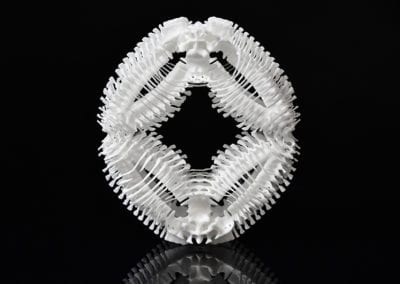MORPHOLOGIES OF RESURRECTION
2020
biocompatible polyamide
(series of 6 sculptures)
How can we use information from the past, including that of extinct species, to learn about form and function to create new forms and organisms that could potentially heal and enhance our bodies, environment and various species?
Designed from portions extracted from the spine of the Smithsonian Institution’s 3D scan data of a Triceratops fossil, Morphologies of Resurrection imagines new forms based on extinct species, depicting hypothetical evolutions through technological regeneration and evolutionary computing. The six finely detailed sculptures are presented as both specimens and relics to reinforce that the possibilities and limitations of reconstructive morphologies and enhancement through evolutionary technology as something to be studied and researched; as well as to be contemplated with veneration, as the use of such technology can permanently alter evolution, the planet, and various species, including humanity.
Developed in collaboration with the Smithsonian Institution.
Learn more about Artist Amy Karle & The Smithsonian Institution’s collaboration, Regeneration Through Technology at https://www.amykarle.com/project/_smithsonian_collaboration/
MORPHOLOGIES OF RESURRECTION | Exhibition Record
The Smithsonian Institution’s National Museum of American History
(exhibited in conjunction with “Open Access” Launch) 2020
Washington, DC USA
Science Gallery Rotterdam at Erasmus MC: “[UN]REAL” 2020
Rotterdam, The Netherlands
Ars Electronica Garden Rotterdam: “In Kepler’s Gardens”
(cross exhibited with “[UN]REAL”) 2020
Rotterdam, The Netherlands
A VERY SPECIAL THANK YOU TO:
The Smithsonian Institution
The Smithsonian National Museum of Natural History
The Smithsonian Digitization Program Office
Smithsonian Open Access
HP and HP Labs
and to all those whose generous support made this project possible.








